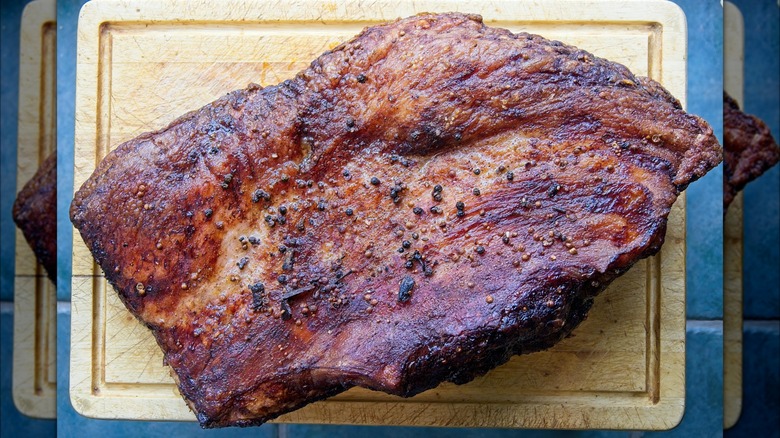Andrew Zimmern's Top Tip For Choosing A Cut Of Brisket
Firing up the backyard smoker is a fun and rewarding project, but it's one that takes a bit of planning and a definite time investment. This can make prep a little intimidating, especially if you're putting everything into one major cut of meat. We're talking about brisket, and even the professionals find this one challenging. In an interview with Parade, Andrew Zimmern revealed, "[Brisket is] extremely difficult to cook. But if you follow a couple of easy principles, it's not that hard."
That starts right from heading to the store to pick out your brisket, and if you're not sure what to look for, it's easy to end up with a piece of meat that's less than perfect. There's a ton of advice floating around out on the internet, but one of the things that many agree with Zimmern on is the fact that brisket's fat content is incredibly important. That's because brisket is sourced from the chest, which means it comes from a part of the animal that's worked a lot and can end up being tough — even when it's smoked.
At a glance, Zimmern's advice might look like it makes cooking brisket more challenging than you might expect. But with years of experience — and the fact that cooking brisket is a family favorite — it's safe to say that when he suggests buying not one section of brisket but the entire thing, he knows what he's talking about.
Here's why Andrew Zimmern opts for the whole brisket
Zimmern says that to get the best brisket, you'll need to get a whole one, and let's talk about exactly what that means. Brisket is a cut of meat that can be thought of as two separate but overlapping muscles that might be labeled using a few different names. There's a large, flat, rectangular piece that might be referred to as either the first cut or the flat, and the other piece is referred to as either the point, the deckle, the second cut, or the crown. This is the piece that's thicker, heavier, less uniformly shaped, and fattier. Many butchers will sell the two pieces separately, and it makes sense: They cook at different rates.
But Zimmern explains that getting a whole brisket allows you to balance the fat content. In some cases, the flat isn't going to have enough, and fat adds flavor and is needed to keep the brisket from drying out. The flat alone, he says, leaves "very little leeway on nailing it just right." Keep the fattier point muscle, though, and you know you're going to have the fat you need.
This comes with a caveat, though. Zimmern says that when you get a whole brisket, it can be more difficult to get it to cook evenly. There's an easy fix for this: Instead of getting the largest ones you can find, stick with cuts that are around six to nine pounds.
Zimmern says fat is the key to serving up the best brisket
According to Zimmern, his brisket know-how largely comes from his grandmother. She was the one who originally developed the recipe that became a family favorite, and he told Parade that he's learned a lot over the years — particularly about how fat can be used to create the perfect brisket.
In addition to selecting the whole brisket, Zimmern says that you should leave most of the fat on. Before putting it on the smoker, pull it out of the fridge and let it sit at room temperature for a bit. That's called tempering, and Zimmern says that once the chill from the fridge is gone, that's going to make it easy to cut off any "big chunks of extraneous fat." The rest? Leave it.
It might seem like a bit of a strange thing to do, but he says that the fat is so full of flavor that letting it melt into the rest of the meat will seriously upgrade your brisket game. He adds, "When I'm slicing my brisket to serve hours later, that's when I can trim that fat off. It's already done its job." He's even perfected a fridge hack for removing that pesky brisket fat, which involves letting it cool in the fridge overnight. That will allow the fat to congeal: Just peel it off, and everything that's left will be perfect, flavorful, tender leftover brisket that's perfect for meals like a hearty brisket and barley stew, or even using in brisket egg rolls.


